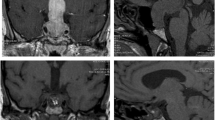Abstract
Aggressive pituitary adenomas are notoriously difficult to manage due to their size, invasiveness, speed of growth and high frequency of recurrence. Except for prolactinomas, surgery (usually transsphenoidal but sometimes transcranial) is the first-line option, but re-growth of aggressive tumors is almost inevitable and monitoring and repeat surgery is required to control symptoms. In prolactinomas, dopamine agonists are the first-line treatment and they normalize prolactin levels in most patients even with macroprolactinomas. Somatostatin analogues offer another pharmacotherapy for pituitary adenomas either for primary therapy, pre-operatively to reduce the tumor volume and make it more amenable to surgical removal, or post-surgery to control re-expansion. When surgery and pharmacotherapy fail, radiotherapy is a useful third-line strategy that reduces recurrence, while extreme pituitary adenomas with metastases may potentially be managed with chemotherapy (although more data are needed). A combination of these therapies will be required for aggressive pituitary adenomas and careful follow-up is essential.



Similar content being viewed by others
References
Schloffer H (1907) Erfolgreiche Operation eines Hypophysentumors auf nasalem Wege. Wien Klin Wochenschr 20:621–624
Gillam MP, Molitch ME, Lombardi G, Colao A (2006) Advances in the treatment of prolactinomas. Endocr Rev 27(5):485–534. doi:10.1210/er.2005-9998
Biller BM, Molitch ME, Vance ML et al (1996) Treatment of prolactin-secreting macroadenomas with the once-weekly dopamine agonist cabergoline. J Clin Endocrinol Metab 81(6):2338–2343. doi:10.1210/jc.81.6.2338
Colao A, Di Sarno A, Landi ML et al (1997) Long-term and low-dose treatment with cabergoline induces macroprolactinoma shrinkage. J Clin Endocrinol Metab 82(11):3574–3579. doi:10.1210/jc.82.11.3574
Colao A, Di Sarno A, Landi ML et al (2000) Macroprolactinoma shrinkage during cabergoline treatment is greater in naive patients than in patients pretreated with other dopamine agonists: a prospective study in 110 patients. J Clin Endocrinol Metab 85(6):2247–2252. doi:10.1210/jc.85.6.2247
Ferrari CI, Abs R, Bevan JS et al (1997) Treatment of macroprolactinoma with cabergoline: a study of 85 patients. Clin Endocrinol (Oxf) 46(4):409–413. doi:10.1046/j.1365-2265.1997.1300952.x
Webster J, Piscitelli G, Polli A, Ferrari CI, Ismail I, Scanlon MF (1994) A comparison of cabergoline and bromocriptine in the treatment of hyperprolactinemic amenorrhea. Cabergoline comparative study group. N Engl J Med 331(14):904–909. doi:10.1056/NEJM199410063311403
Verhelst J, Abs R, Maiter D et al (1999) Cabergoline in the treatment of hyperprolactinemia: a study in 455 patients. J Clin Endocrinol Metab 84(7):2518–2522. doi:10.1210/jc.84.7.2518
Zatelli MC, Ambrosio MR, Bondanelli M, Uberti EC (2007) Control of pituitary adenoma cell proliferation by somatostatin analogs, dopamine agonists and novel chimeric compounds. Eur J Endocrinol 156(suppl 1):S29–S35. doi:10.1530/eje.1.02352
Vance ML, Laws ER Jr (2005) Role of medical therapy in the management of acromegaly. Neurosurgery 56(5):877–885. discussion-85
Caron P, Bex M, Cullen DR et al (2004) One-year follow-up of patients with acromegaly treated with fixed or titrated doses of lanreotide Autogel. Clin Endocrinol (Oxf) 60(6):734–740. doi:10.1111/j.1365-2265.2004.02045.x
Maiza JC, Vezzosi D, Matta M et al (2007) Long-term (upto 18 years) effects on GH/IGF-1 hypersecretion and tumour size of primary somatostatin analogue (SSTa) therapy in patients with GH-secreting pituitary adenoma responsive to SSTa. Clin Endocrinol (Oxf) 67(2):282–289. doi:10.1111/j.1365-2265.2007.02878.x
Mercado M, Borges F, Bouterfa H et al (2007) A prospective, multicentre study to investigate the efficacy, safety and tolerability of octreotide LAR (long-acting repeatable octreotide) in the primary therapy of patients with acromegaly. Clin Endocrinol (Oxf) 66(6):859–868. doi:10.1111/j.1365-2265.2007.02825.x
Karavitaki N, Turner HE, Adams CB et al (2008) Surgical debulking of pituitary macroadenomas causing acromegaly improves control by lanreotide. Clin Endocrinol (Oxf) 68(6):970–975. doi:10.1111/j.1365-2265.2007.03139.x
Bevan JS (2005) Clinical review: the antitumoral effects of somatostatin analog therapy in acromegaly. J Clin Endocrinol Metab 90(3):1856–1863. doi:10.1210/jc.2004-1093
Colao A, Marzullo P, Ferone D et al (1999) Effectiveness and tolerability of slow release lanreotide treatment in active acromegaly. J Endocrinol Invest 22(1):40–47
Cozzi R, Barausse M, Sberna M et al (2000) Lanreotide 60 mg, a longer-acting somatostatin analog: tumor shrinkage and hormonal normalization in acromegaly. Pituitary 3(4):231–238. doi:10.1023/A:1012832230598
Colao A, Pivonello R, Auriemma RS et al (2006) Predictors of tumor shrinkage after primary therapy with somatostatin analogs in acromegaly: a prospective study in 99 patients. J Clin Endocrinol Metab 91(6):2112–2118. doi:10.1210/jc.2005-2110
Mortini P, Barzaghi R, Losa M, Boari N, Giovanelli M (2007) Surgical treatment of giant pituitary adenomas: strategies and results in a series of 95 consecutive patients. Neurosurgery 60(6):993–1002 discussion 3-4
Fadul CE, Kominsky AL, Meyer LP et al (2006) Long-term response of pituitary carcinoma to temozolomide. Report of two cases. J Neurosurg 105(4):621–626. doi:10.3171/jns.2006.105.4.621
Lim S, Shahinian H, Maya MM, Yong W, Heaney AP (2006) Temozolomide: a novel treatment for pituitary carcinoma. Lancet Oncol 7(6):518–520. doi:10.1016/S1470-2045(06)70728-8
Syro LV, Uribe H, Penagos LC et al (2006) Antitumour effects of temozolomide in a man with a large, invasive prolactin-producing pituitary neoplasm. Clin Endocrinol (Oxf) 65(4):552–553. doi:10.1111/j.1365-2265.2006.02653.x
Kovacs K, Horvath E, Syro LV et al (2007) Temozolomide therapy in a man with an aggressive prolactin-secreting pituitary neoplasm: morphological findings. Hum Pathol 38(1):185–189. doi:10.1016/j.humpath.2006.07.014
Neff LM, Weil M, Cole A et al (2007) Temozolomide in the treatment of an invasive prolactinoma resistant to dopamine agonists. Pituitary 10(1):81–86. doi:10.1007/s11102-007-0014-1
Kovacs K, Scheithauer BW, Lombardero M et al (2008) MGMT immunoexpression predicts responsiveness of pituitary tumors to temozolomide therapy. Acta Neuropathol 115(2):261–262. doi:10.1007/s00401-007-0279-5
Author information
Authors and Affiliations
Corresponding author
Rights and permissions
About this article
Cite this article
Buchfelder, M. Management of aggressive pituitary adenomas: current treatment strategies. Pituitary 12, 256–260 (2009). https://doi.org/10.1007/s11102-008-0153-z
Published:
Issue Date:
DOI: https://doi.org/10.1007/s11102-008-0153-z




